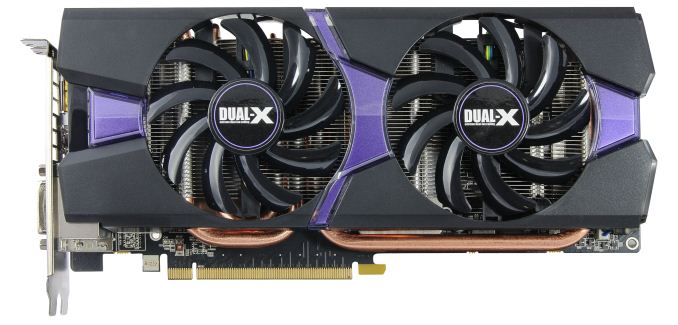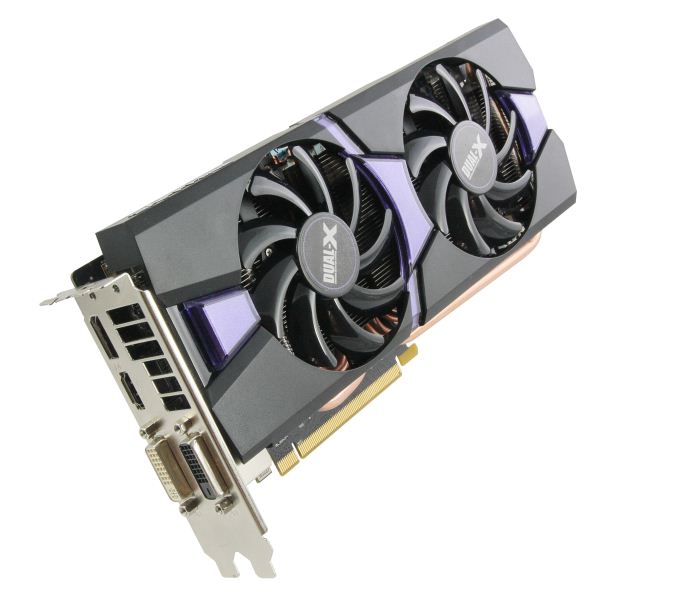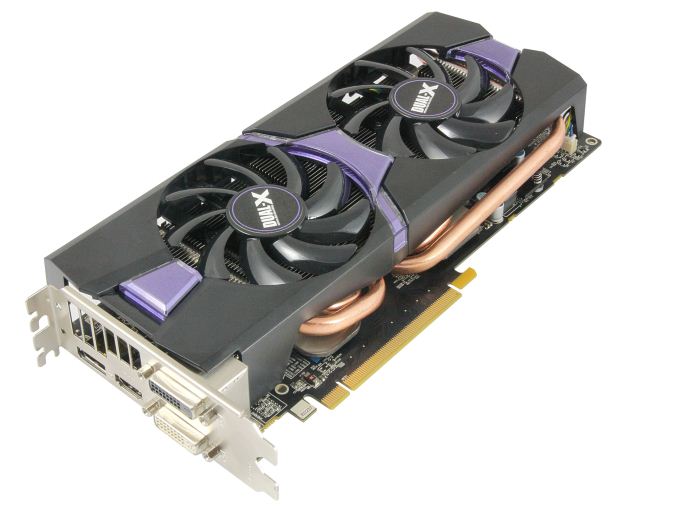AMD Radeon R9 285 Review: Feat. Sapphire R9 285 Dual-X OC
by Ryan Smith on September 10, 2014 2:00 PM ESTMeet The Sapphire R9 285 Dual-X OC 2GB
Our sample provided by AMD for today’s launch is Sapphire’s R9 285 Dual-X OC 2GB. As we mentioned before this is a non-reference launch, so rather than ship out engineering cards that won’t see retail AMD has sent us proper retail cards.
Sapphire’s R9 285 Dual-X OC is in turn a good example of what kinds of cards are appearing on store shelves. As R9 285 is a sub-200W product all of the launch cards have followed the same basic design, utilizing their manufacturer’s respective dual fan open air designs. So if you like full size open air cards then you’ll have your pick of the litter. However it also means that there aren’t any blowers on the market – nor do we expect any in the development pipeline – so for the moment the market for R9 285s is rather homogenous. In Sapphire’s case, though not available at launch, we will eventually see them break the mold with a smaller single-fan card specifically designed for use in ITX systems.
But getting to the R9 285 Dual-X OC, the Dual-X is a solid entry from Sapphire that is very typical of their current designs. As given away by the name, this card utilizes a 10” version of Sapphire’s Dual-X open-air cooler, and among Sapphire’s product lineup it can be considered the company’s baseline cooler for products up to 250W. Meanwhile as an OC model Sapphire is shipping this card with a mild factory overclock of 965MHz for the core and 5.6GHz for the memory, which represents a 47MHz (5%) core overclock and 100MHz (2%) memory overclock. Though note that Sapphire is also producing an identical version of this hardware without the factory overclock.
Continuing with our overall theme of R9 285 being a lateral product for AMD, the same is unsurprisingly true for Sapphire. For the R9 285 Dual-X Sapphire has opted to port over the design of their existing R9 280 Dual-X (which happens to be our R9 280 test card), building a suitable new PCB for Tonga but otherwise retaining the R9 280’s cooler and functionality. With R9 280 being a more power hungry part (on paper at least), this means the R9 285 Dual-X cooler is slightly overpowered in comparison, which should bode well for temperature/acoustic performance and for overclocking.
The Dual-X cooler itself is something of a tried and true design for Sapphire at this point, as years of iteration on dual fan coolers has resulted in these designs coalescing into similar and highly effective coolers. Starting from the top, the 10” version of the Dual-X cooler utilizes a pair of 85mm fans, allowing it to provide more than sufficient airflow for the primary and VRM heatsinks. Buyers with cramped cases will want to note that the use of such a large fan does result in a shroud larger than the PCB itself, with the shroud extending an additional 1cm over the PCB.
Below the fans we find Sapphire’s primary heatsink, which is composed of aluminum and runs just short of the entire length of the cooler. Sapphire attaches the primary heatsink to the GPU through the use of 4 copper heatpipes which run between the GPU and various points on the heatsink. The heatpipes in turn do not make direct contact with the GPU, but instead attach to a copper baseplate which in turn is what makes contact with the GPU and channels heat into the heatpipes.
Surrounding the copper baseplate is a secondary aluminum baseplate which provides both structure for the overall heatsink and additional cooling. Through the use of thermal pads, the aluminum baseplate covers the card’s RAM chips, providing direct cooling for the RAM. Meanwhile the card’s VRMs are not part of the primary heatsink assembly, and are instead cooled via a smaller secondary “strip” heatsink that sits over the MOSFETs towards the rear of the card. Airflow making it through the primary heatsink is in turn responsible for cooling this secondary heatsink.
Removing the heatsink and accessing the PCB, Sapphire’s PCB is typical for a 200W card. Sapphire places the bulk of the VRM circuitry towards the rear of the card, between the GPU/RAM and the PCIe power sockets. Meanwhile Sapphire’s RAM of choice is 6GHz Elpedia, which means this card ships at a lower memory frequency than what the RAM is capable of. For overclockers this means there’s some guaranteed headroom on the RAM, while the lower shipping frequency may indicate that AMD has tuned Tonga’s memory controllers for sub-6GHz operation, similar to what happened with Hawaii.
Throughout all of this the R9 285 Dual-X OC is generally a solid card, but the heatsink/PCB interaction does expose the card’s one real weakness/design flaw, which is a lack of rigidity. As is almost always the case with these large heatsink cards, the heatsink is massive enough that for all practical purposes the PCB is attached to the heatsink rather than vice versa. However Sapphire only attaches the heatsink to the PCB at the 4 screws around the GPU, which for a 10.25” card means the far end of the card is far removed from these attachment points and is left free to flex. Sapphire does include a plastic leg at one corner of the shroud to keep the PCB from flexing too much, but this leg isn’t secured to the PCB and indeed isn’t even long enough to touch the PCB without flexing. Ideally we would like to see all 9”+ cards reinforced against flexing for this reason, either by securing the shroud to the PCB at the rear of the card or by employing a stiffener along the top edge of the PCB.
Moving on, Sapphire doesn’t list an official TDP for the R9 285 Dual-X OC, however given the factory overclock it’s fair to say that in practice it’s going to be a bit higher than AMD’s official 190W TDP of a stock R9 285. Providing power for the card is a pair of 6pin PCIe power connectors at the top-rear of the card, which along with the PCIe slot connector means the card has the means to deliver up to 225W of power (VRMs willing). Interestingly Sapphire’s PCB has an additional pair of solder points for replacing one of the 6pin connectors with an 8pin connector, which may indicate a future Sapphire card or Sapphire hedging their bets for the inevitable higher tier Tonga card with all 32 CUs enabled.
Meanwhile though you won’t find a Crossfire connector at the top of the card – having been made obsolete by GCN 1.1+’s XDMA engines – what you will find on the Sapphire card is a BIOS switch. Sapphire ships the R9 285 Dual-X as a dual BIOS UEFI card, with one BIOS for legacy systems and a second BIOS for UEFI systems. The card’s default shipping state will be for the legacy BIOS, while depressing the BIOS button will switch to UEFI. Outside of reference cards we don’t see too many dual BIOS cards, and given the limited selection of such cards we are rather fond of the fact that Sapphire uses a button here as opposed to a more difficult to access switch.
Finally, towards the front of the card we see the standard AMD 200 series I/O configuration of 1x DL-DVI-I, 1x DL-DVI-D, 1x HDMI, and 1x DisplayPort. Tonga has up to 6 display controllers, and while not easy it should be possible to use all 6 of them through a careful use of MST off of the DisplayPort and identical monitors hanging off of the HDMI and DVI ports.
Wrapping things up, the retail price on the R9 285 Dual-X OC is currently running at $259. This puts Sapphire’s card at $10 over the R9 285 MSRP of $249, though given the fact that this is a factory overclocked card this is par for the course. We haven’t seen the non-OC version for sale yet, but one way or another you’re essentially looking at paying a 4% price premium for roughly as much of a performance advantage over a stock R9 285.














86 Comments
View All Comments
TiGr1982 - Thursday, September 11, 2014 - link
BTW, is Tonga the only new GPU AMD has to offer in 2014?(if I'm not mistaken, the previous one from AMD, Hawaii, was released back in October 2013, almost a year ago)
Does anybody know?
HisDivineOrder - Thursday, September 11, 2014 - link
The thing is the moment I heard AMD explaining how Tonga was too new for current Mantle applications, I was like, "And there the other shoe is dropping."The promise of low level API is that you get low level access and the developer gets more of the burden of carrying the optimizations for the game instead of a driver team. This is great for the initial release of the game and great for the company that wants to have less of a (or no) driver team, but it's not so great for the end user who is going to wind up getting new cards and needing that Mantle version to work properly on games no longer supported by their developer.
It's hard enough getting publishers and/or developers to work on a game a year or more after release to fix bugs that creep in and in some cases hard to get them to bother with resolution switches, aspect ratio switches, the option to turn off FXAA, the option to choose a software-based AA of your choice, or any of a thousand more doohickeys we should have by now as bog-standard. Can you imagine now relying on that developer--many of whom go completely out of business after finishing said title if they happen to work for Activision or EA--to fix all the problems?
This is why a driver team is better working on it. Even though the driver team may be somewhat removed from the development of the game, the driver team continues to have an incentive to want to fix that game going forward, even if it's a game no longer under development at the publisher. You're going to be hard pressed to convince Bobby Kotick at Activision that it's worth it to keep updating versions of games older than six months (or a year for Call of Duty) because at a certain point, they WANT you to move on to another game. But nVidia and AMD (and I guess Intel?) want to make that game run well on next gen cards to help you move.
This is where Mantle is flawed and where Mantle will never recover. Every time they change GCN, it's going to wind up with a similar problem. And every time they'll wind up saying, "Just switch to the DX version." If Mantle cannot be relied upon for the future, then it is Glide 2.0.
And why even bother at all? Just stick with DirectX from the get-go, optimize for it (as nVidia has shown there is plenty of room for improvement), and stop wasting any money at all on Mantle since it's a temporary version that'll rapidly be out of date and unusable on future hardware.
The-Sponge - Thursday, September 11, 2014 - link
I do not understand how they got there R9 270x temperatures, my OC'd R9 270x never even comes close to the temps they got....mac2j - Friday, September 12, 2014 - link
It's great that they've caught up with H.264 on hardware and the card otherwise looks fine. The bottom line for me, though, is that I don't see the point of buying card now without H.265 on hardware and an HDMI 2.0 port - 2 things Maxwell will bring this year. I haven't heard what AMDs timetable is there though.P39Airacobra - Friday, October 17, 2014 - link
It really irritates me that they are making these cards throttle to keep power and temps down! That is pathetic! If you can't make the thing right just don't make it! Even if it throttles .1mhz it should not be tolerated! We pay good money for this stuff and we should get what we pay for! It looks like the only AMD cards worth anything are the 270's and under. It stinks you have to go Nvidia to get more power! Because Nvidia really rapes people with their prices! But I must say the GTX 970 is priced great if it is still around $320. But AMD should have never even tried with this R9 285! First of all when you pay that much you should get more than 2GB. And another thing the card is pretty much limited to the performance of the R9 270's because of the V-Ram count! Yeah the 285 has more power than the 270's, But whats the point when you do not have enough V-Ram to take the extra power were you need a card like that to be? In other words if you are limited to 1080p anyway, Why pay the extra money when a R7 265 will handle anything at 1080p beautifully? This R9 285 is a pointless product! It is like buying a rusted out Ford Pinto with a V-8 engine! Yeah the engine is nice! But the car is a pos!P39Airacobra - Friday, January 9, 2015 - link
(QUOTE) So a 2GB card is somewhat behind the times as far as cutting edge RAM goes, but it also means that such a card only has ¼ of the RAM capacity of the current-gen consoles, which is a potential problem for playing console ports on the PC (at least without sacrificing asset quality).(SIGH) So now even reviewers are pretending the consoles can outperform a mid range GPU! WOW! How about telling the truth like you did before you got paid off! The only reason a mid range card has problems with console ports is because they are no longer optimized! They just basically make it run on PC and say xxxx you customers here it is! And no the 8GB on the consoles are used for everything not for only V-Ram! We are not stupid idiots that fall for anything like the idiots in Germany back in the 1930's!